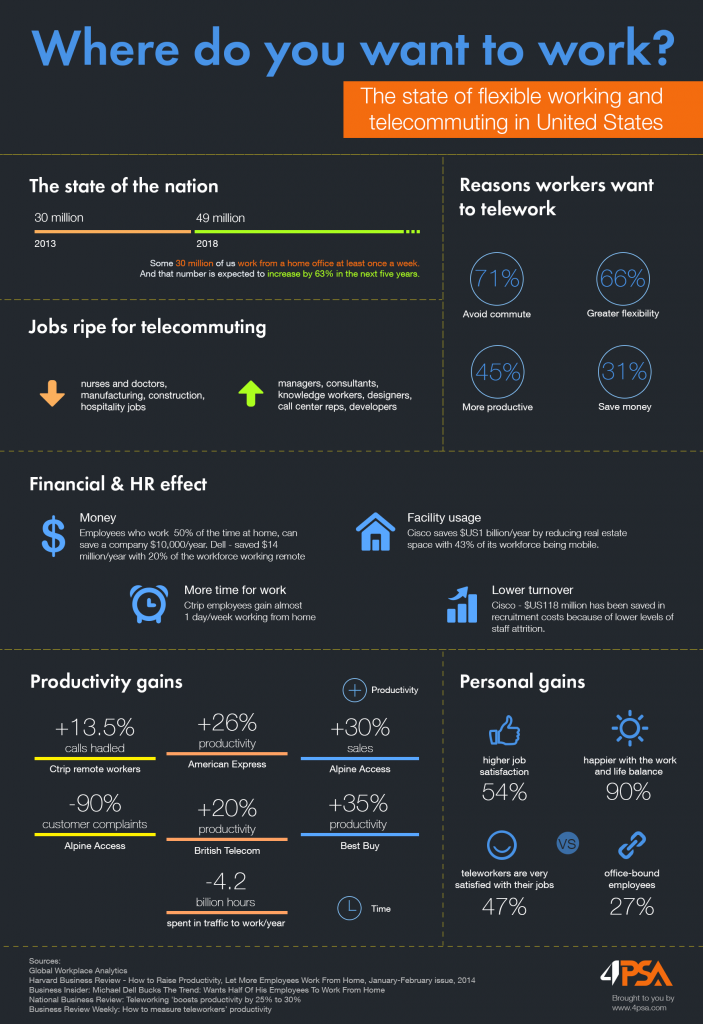Last year, Yahoo CEO Marissa Mayer made the headlines when she announced that her employees would no longer be able to work from home. Some industry pundits speculated as to whether that meant the end of remote jobs. A few months later however, Dell CEO Michael Dell announced his intention to enable half of his 14,000 workforce to work from home. At the time of his announcement, 20 percent of his team were already working from home.
So, while the jury is still out whether Yahoo fares better or not, Dell’s decision merely expanded what already proved to be a good decision: in 2012, thanks to its remote working policy, the company saved $14 million—and 6,735 metric tons of carbon dioxide emissions. It seems that offices will soon be a thing of the past, or at least will need to be re-imagined, as more and more companies are shifting to flexible working policies.
In early 2013, about one in five Americans worked from home. According to the Telework Research Network, that number is expected to rise to 63% over the next five years, as businesses tend to embrace a more mobile and flexible workforce.
In the past, employees needed to be at the office to get their jobs done. When the email became the stage of work practices, it brought a huge cultural shift in businesses. Yet, nowadays, thanks to several trends, we are witnessing an even larger shift. For instance, because of the pervasive Internet penetration, mentalities about a 9 to 5 job changed to a great extent. And with it, so did technology. In fact, technology has evolved to the point where all employees can access the tools they need to be productive from anywhere as long as they have an Internet connection. This is truly an exciting time for companies that allow for remote or flexible working. Of course, employees working in manufacturing are still tied and will be tied to their work benches a long time from now.
Of all these powerful trends, let’s take a closer look at technology, namely at Unified Communications in the Cloud. UC tools – technology that combines voice, video, instant messaging and presence, into a single interface running on any device – gives employees and companies, a variety of benefits:
- Personal productivity. Harvard Business Review talks about an interesting case – Ctrip, a Chinese travel website with a large call center. The management decided to run an experiment to see if remote working brings real benefits indeed, so it allowed half of its employees to work from home. Nine months later, the management found that people working from home completed 13.5% more calls than the staff in the office did (the control group). Not only did they report much higher work satisfaction, but as it turned out the number of people quitting their remote job went down by 50% compared to that of people working in the office. Telework reports that from Best Buy to British Telecom, productivity gains are between 20% to 35%, and that’s a big bounce!
- Team productivity. Until recently, by working together, employees understood that they would have to be in the same building. With UC, that’s no longer the case. Instead, employees can easily gauge when their coworkers are available, even if both of them happen to be sitting on their couches at home. This means that when inspiration strikes on a random Thursday night, employees will have the tools they need to get to work right away, but don’t kid yourself this will happen too often 😉
- Mobility. Let’s say you are a growing delivery company and your sales associates and drivers are increasingly out of the office and on the road attracting new business and servicing existing clients. For them, being out of the office cannot possibly mean being out of touch. To do their jobs, they need to have the same or better access to all of the resources and data they need, no matter where they are. With UC tools at their disposal, they’re able to access pertinent communications no matter where they happen to be, as long as they can access the Internet from their mobile devices. For customers, this accessibility translates into superior service and ensures a positive experience.
- Job satisfaction & flexibility. Employees are increasingly expecting to work from home, at least partially, so they can manage their complex personal lives and still be at the height of their professional productivity. The most comprehensive UC solutions will allow them to do this with ease, as they’ll be able to communicate and collaborate as if they were in the office. On top of that, according to Mobile Work Exchange, if all U.S. employees worked remotely just one day a year, they’d collectively save $36 billion. Not to mention that remote employees constantly report feeling happier and less stressed than their counterparts stuck at desks.
These are just some of the most prominent benefits, yet there are many others such as reduced facility costs, lowered absenteeism, less time spent commuting, lower personnel turnover and even a larger pool of applicants – for example, mothers who would only take flexible jobs, that over time add up to significant savings.
In addition to providing businesses with unmatched utility, UC tools help companies cater to today’s shifting workplace paradigm, where more employees find themselves working from home or working on the go than ever before. As such, resellers should consider enhancing their portfolios by adding cloud-based UC tools to their offerings.

1 Comment
You can post comments in this post.
Yeah, Unified communications encompasses several communication systems or models including unified messaging, collaboration, and interaction systems; real-time and near real-time communications; and transactional applications.
Tiktikie 9 years ago
Post A Reply